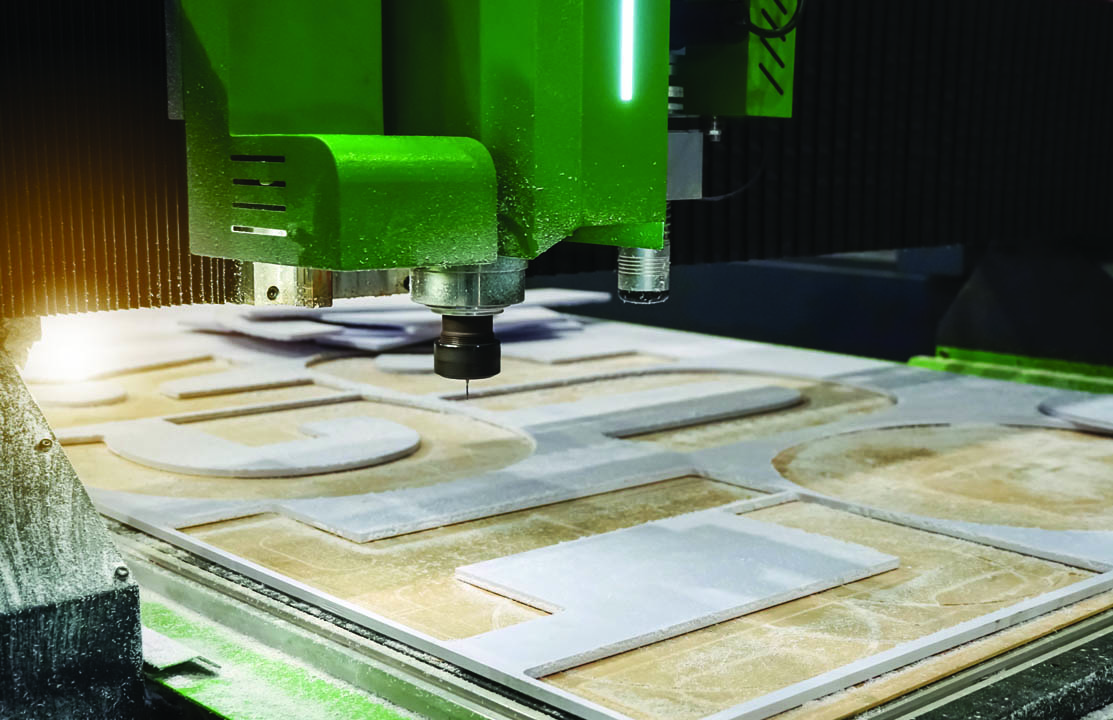In the world of manufacturing and sign-making, precision and efficiency are the keys to success. When it comes to adding CNC routers and waterjets to your shop, careful consideration is essential to ensure you’re making the most of your investment. In this article, we’ll explore the top considerations when adding a CNC router to your shop, techniques for improving edge quality when routing various materials, and why you should consider adding a waterjet to your sign shop.
Top considerations when adding a CNC router
- Availability of forklift — Before bringing a CNC router into your shop, consider whether you have access to a forklift or the means to move heavy machinery. CNC routers can be substantial in size and weight, and proper handling is essential for both safety and installation.
- Garage door width — Ensure that your shop’s garage door is wide enough to accommodate the CNC router’s dimensions. CNC routers can come in various sizes, so it’s crucial to have sufficient clearance for smooth installation.
- Shop layout — Optimizing your shop layout is crucial for an efficient workflow. Plan the placement of your CNC router, dust collection system, and vacuum pump to maximize space and productivity.
- Space allocation — Determine the dedicated space for your CNC router, dust collection system, and vacuum pump. Adequate space allocation is necessary for seamless operations and safety.
- Shop voltage — Check the voltage requirements of your CNC router and ensure your shop’s electrical system can support it. Voltage issues can lead to performance problems, so it’s vital to have the correct setup.
- Workflow considerations — Review your workflow and how the CNC router fits into it. Make sure you have a clear plan for the machine’s usage, including tool changes, material loading, and unloading.
Improving edge quality when routing different materials
Achieving superior edge quality when routing various materials is crucial for sign-making applications. Here are some techniques to enhance the finish:
- Router system quality — Investing in a high-quality CNC router system is the foundation for achieving excellent edge quality. A reliable system with precision controls will significantly impact the quality of your finished products.
- Cold air gun (for plastics) — When working with plastic materials, consider using a cold air gun. This tool helps cool the material during cutting, reducing heat-related deformities and improving edge quality.
- Spray mister (for non-ferrous metals) — For nonferrous metals, a mister system can help lubricate the cutting area and prevent overheating. This results in cleaner edges and increased tool lifespan.
- High-capacity pressure foot — Utilizing a high-capacity pressure foot ensures proper material support during cutting. This reduces vibrations and enhances edge quality, especially when routing thicker materials.
- Good dust collection — Maintaining an efficient dust collection system is crucial to prevent chip buildup and ensure proper airflow. This helps avoid rewelding of chips onto the material, resulting in cleaner cuts.
- Onion skin technique — Implement the onion skin technique, both radially and in the Z-axis. This involves leaving a thin, uncut layer at the bottom of the material, which stabilizes the cut and improves edge quality.
- Correct endmill selection — Choosing the right endmill for your material is essential. Consult with the manufacturer’s application team to select the appropriate tool for your specific routing needs.
Dealing with finicky materials
Certain materials can be challenging to work with, but with the right techniques and tools, you can overcome these challenges:
- Surfaced waste board — Ensure your waste board is properly surfaced and clean. Any debris on the waste board can compromise vacuum hold-down, leading to parts vibrating and reduced cut quality.
- Uneven waste board — An uneven waste board can affect precision in engraving and through cuts. Regularly check and level your waste board to maintain accuracy.
- Warped material — Warped materials may require the use of nose riders and roller hold-down options to keep them flat during routing.
- Vision system — Consider investing in a router with a good camera, or vision system, which simplifies alignment of organic sheets with just a touch of a button. This significantly reduces setup time and enhances precision.
Why you should add a waterjet to your sign shop
Incorporating waterjet technology into your sign shop can be a game-changer for several reasons:
- Complementary to CNC router — Waterjets complement CNC router technology by offering a different cutting method. This combination can accelerate your manufacturing processes and increase versatility.
- Cut through any material — A waterjet can cut through virtually any material placed on its bed, including stone, iron, carbon fiber, and more. This versatility allows for a broader range of applications.
- Fast processing for foam — Waterjets are exceptionally fast when processing foam materials using only water. This is particularly useful for through cuts and saves time and resources.
Adding CNC routers and waterjets to your sign shop can open up new possibilities for precision and efficiency in your manufacturing processes. Careful consideration of the factors mentioned, along with the implementation of techniques to improve edge quality and handle finicky materials, will ensure that your investment yields exceptional results.
Additionally, incorporating waterjet technology alongside CNC router technology can further enhance your capabilities, making your shop more versatile and competitive in the industry. Stay updated with the latest advancements in CNC router and waterjet technology to continuously improve your shop’s efficiency and productivity.




